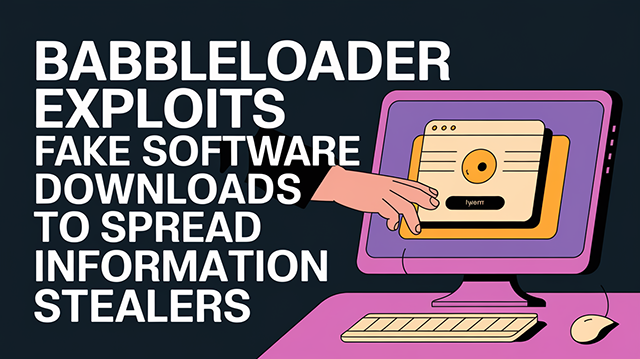BabbleLoader Exploits Fake Software Downloads to Spread Information Stealers

Threat Group: Unknown
Threat Type: Malware Loader
Exploited Vulnerabilities: None identified; utilizes evasion techniques
Malware Used: BabbleLoader
Threat Score: High (8.5/10) — Due to its advanced evasion capabilities, sophisticated delivery mechanisms, and ability to facilitate various malware payloads.
Last Threat Observation: November 19, 2024.
Overview
BabbleLoader is a newly discovered and highly stealthy malware loader that has been observed delivering information stealer malware families, including WhiteSnake and Meduza, in the wild. Researchers from Intezer described it as an "extremely evasive loader, packed with defensive mechanisms, designed to bypass antivirus and sandbox environments to deliver stealers into memory."
The loader has been linked to multiple campaigns targeting both English and Russian-speaking individuals. Notably, these campaigns have used social engineering to target users searching for cracked software as well as business professionals in finance and administration, disguising the loader as accounting software.
As the first stage in the malware attack chain, loaders like BabbleLoader play a crucial role in bypassing traditional antivirus defenses, making it a growing concern for cybersecurity teams worldwide.
Key Details
- Delivery Method: BabbleLoader is distributed through malicious websites masquerading as legitimate download pages, offering fake software.
- Target: English and Russian-speaking individuals, particularly:
- Users seeking cracked software.
- Professionals in finance and administration.
- Functions:
- Bypasses antivirus and sandbox defenses using anti-analysis features.
- Delivers malware payloads, such as information stealers, into system memory.
- Employs advanced junk code and metamorphic transformations to evade signature and behavioral detections.
- Resists analysis by disabling disassembly tools like IDA, Ghidra, and Binary Ninja.
- Randomizes metadata, structure, and control flow for each unique sample, impeding AI-based detection systems.
- Obfuscation: BabbleLoader incorporates numerous techniques to prevent detection, including:
- Junk code to overload decompilers.
- Metamorphic transformations to ensure unique code structure in every sample.
- Runtime function resolution to evade static analysis.
- Excessive noisy code that causes reverse engineering tools to fail.
Attack Vectors
BabbleLoader is distributed primarily via malicious websites offering fake or cracked software downloads. Once downloaded and executed, BabbleLoader employs a sequence of stealth mechanisms:
- Initial Loader Execution: BabbleLoader decrypts and loads shellcode into memory.
- Payload Staging: The shellcode deploys a Donut loader, which unpacks and executes the ultimate malware payload.
- Payload Deployment: This stage is used to deliver information-stealing malware directly into memory, avoiding detection by antivirus or sandbox environments.
Its ability to bypass traditional security tools is further augmented by its capacity to evade AI-based detection models, which struggle to keep up with the loader's constant variability. Each new sample features randomized metadata and control flow, ensuring a high degree of stealth.
Why BabbleLoader Stands Out
Loaders are not new in the cyberthreat landscape, with other families like Dolphin Loader, Emmental, FakeBat, and Hijack Loader propagating various malware types. However, BabbleLoader sets itself apart by its relentless focus on adaptability and obfuscation:
- Each build of BabbleLoader is structurally unique, featuring randomized strings, metadata, and encryption.
- Its disassembly-resistant junk code and runtime-only function resolution prevent static analysis.
- The loader’s architecture is designed to force AI detection systems into a constant state of retraining, which often leads to missed detections and false positives.
This makes BabbleLoader an incredibly resilient tool in a crowded loader/crypter market.
Known Indicators of Compromise (IoCs)
File Hashes (SHA256):
The extensive list of IoCs is available on a dedicated page within this site.
Mitigation and Prevention
- User Awareness:
Educate users about the risks of downloading software from unofficial or unverified sources. Encourage caution when clicking on links offering cracked software or financial tools. - Email Filtering:
Employ robust email filtering systems to block phishing emails distributing malware. - Endpoint Protection:
Keep antivirus and endpoint protection systems updated with the latest signatures to detect BabbleLoader. - Behavioral Analysis Tools:
Deploy behavioral analysis tools to identify anomalous behaviors indicative of BabbleLoader activity. - System Updates:
Regularly update all software and operating systems to address vulnerabilities exploited by loaders like BabbleLoader. - Two-Factor Authentication (2FA):
Use 2FA for added security to protect critical business and financial systems. - Network Monitoring:
Monitor network traffic for unusual activity, especially connections to unknown domains or URLs.
Conclusion
BabbleLoader represents a new evolution in malware loader technology, with unparalleled evasion techniques and adaptability. Its primary focus on delivering information stealers to specific target groups underlines its potential for causing widespread damage, particularly to financial and administrative sectors. Organizations and individuals must prioritize proactive security measures, user education, and continuous monitoring to mitigate this advanced threat.
Sources
- Intezer - "BabbleLoader: the annoyingly clever malware loader"
- The Hacker News - "New Stealthy BabbleLoader Malware Spotted,"


